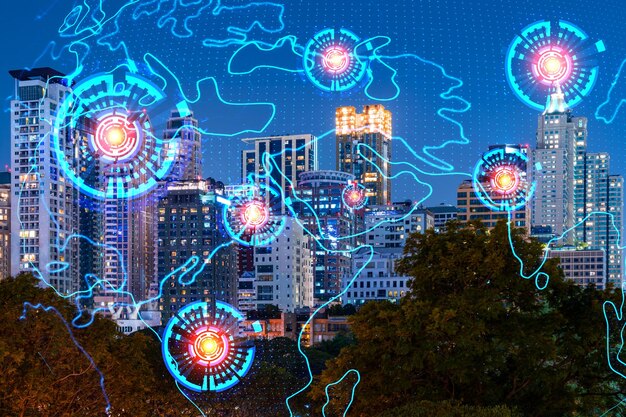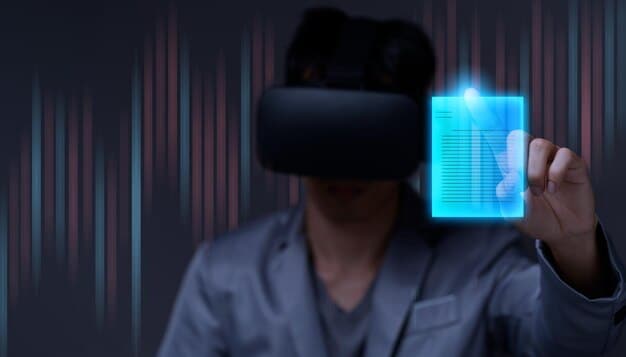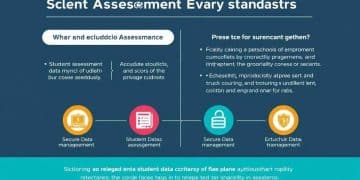VR Security Risks: Protecting Your Business Data

VR security risks encompass various threats in virtual reality, including data breaches, privacy violations, and malware, necessitating robust protection measures for businesses.
The immersive nature of virtual reality (VR) offers unprecedented opportunities for businesses, but it also introduces new VR security risks. Protecting sensitive data in the virtual realm requires a proactive and comprehensive approach.
Understanding the Landscape of VR Security Risks
Virtual reality is rapidly transforming various industries, from training and education to marketing and product development. However, this technological advancement brings with it a unique set of security challenges that businesses must address.
Understanding these risks is the first step toward creating a secure VR environment. Lack of awareness can leave your business vulnerable to data breaches, privacy violations, and other cyber threats.
Data Breaches in VR Environments
One of the primary concerns is the potential for data breaches. VR applications often collect and process vast amounts of user data, including biometric information, movement patterns, and personal preferences. If this data is not properly secured, it can be stolen or accessed by unauthorized parties.
- Data breaches can lead to financial losses and reputational damage.
- Businesses must implement strong encryption and access controls to protect sensitive data.
- Regular security audits and penetration testing can help identify vulnerabilities.
Privacy Concerns in VR
Another critical area is user privacy. VR technology can capture highly personal and intimate data, raising ethical and legal questions. Companies must be transparent about how they collect, use, and store user data, and they must obtain explicit consent from users.

Failing to protect user privacy can result in loss of trust, legal penalties, and damage to brand reputation.
In conclusion, understanding the landscape of VR security risks is crucial for any business looking to leverage this technology. By being aware of the potential threats and implementing proactive security measures, you can protect your data, your users, and your bottom line.
Common VR Security Vulnerabilities
Identifying common vulnerabilities is critical to fortifying VR systems against potential attacks. These vulnerabilities often stem from software flaws, insecure network configurations, and user-related issues.
Addressing these vulnerabilities proactively can significantly reduce the risk of security incidents.
Software Vulnerabilities
VR applications, like any software, can contain vulnerabilities that hackers can exploit. Bugs in the code, outdated libraries, and insecure APIs can all create entry points for attackers.
Regularly updating software and conducting thorough security testing are essential to mitigating these risks.
Network Security
VR systems often rely on network connectivity to deliver immersive experiences. However, if the network is not properly secured, attackers can intercept data, inject malicious code, or launch denial-of-service attacks.
- Implementing strong firewalls and intrusion detection systems can help protect against network-based attacks.
- Use secure protocols like HTTPS and VPNs to encrypt data in transit.
- Regularly monitor network traffic for suspicious activity.
User-Related Vulnerabilities
Users themselves can be a weak link in the security chain. Poor password hygiene, lack of awareness about phishing attacks, and failure to update software can all increase the risk of compromise.

Training users on security best practices and implementing multi-factor authentication can help reduce these risks.
In conclusion, addressing these common VR security vulnerabilities is essential for maintaining a secure VR environment. By focusing on software security, network protection, and user education, businesses can significantly reduce their attack surface.
Implementing Robust Security Measures
To effectively protect your business data in the virtual realm, implementing robust security measures is paramount. These measures should encompass a range of technical and organizational strategies.
A layered approach to security can provide multiple lines of defense, making it more difficult for attackers to succeed.
Encryption and Access Controls
Encryption is a fundamental security measure that protects data by converting it into an unreadable format. Implementing strong encryption algorithms can help prevent unauthorized access to sensitive information.
Access controls can restrict access to VR systems and data based on user roles and permissions. This ensures that only authorized individuals can access sensitive resources.
Regular Security Audits
Security audits involve systematically evaluating the security posture of your VR systems. This can help identify vulnerabilities, assess the effectiveness of security controls, and ensure compliance with relevant regulations.
- Conduct regular vulnerability assessments and penetration testing.
- Review security policies and procedures periodically.
- Implement a robust incident response plan.
Employee Training and Awareness
Employees play a critical role in maintaining a secure VR environment. Providing comprehensive training on security best practices can help them recognize and avoid common threats.
Raising awareness about social engineering attacks, phishing scams, and other common tactics can help employees become more vigilant and proactive.
In conclusion, implementing robust security measures is essential for protecting your business data in VR. By focusing on encryption, access controls, security audits, and employee training, you can create a strong security posture and mitigate the risks of data breaches and other security incidents.
Best Practices for Securing VR Applications
Securing VR applications requires a proactive and holistic approach that addresses every stage of the application lifecycle, from design and development to deployment and maintenance.
Adhering to security best practices can significantly reduce the risk of vulnerabilities and attacks.
Secure Coding Practices
Secure coding practices involve writing code that is resistant to common vulnerabilities. This includes techniques such as input validation, output encoding, and proper error handling.
Using secure coding standards and conducting code reviews can help identify and fix vulnerabilities before they are exploited.
Third-Party Libraries and APIs
VR applications often rely on third-party libraries and APIs to provide specific functionality. However, these components can also introduce security risks if they are not properly vetted and secured.
- Carefully evaluate the security of third-party components before incorporating them into your application.
- Keep third-party libraries and APIs up to date with the latest security patches.
- Monitor for vulnerabilities in third-party components.
User Authentication and Authorization
Implementing strong user authentication and authorization mechanisms is essential for controlling access to VR applications and data. This includes using multi-factor authentication, role-based access control, and regular password resets.
In conclusion, secure development, careful third-party component management, and robust user authentication are crucial for maintaining the security of VR applications. By prioritizing these areas, businesses can mitigate risks and create more secure VR experiences.
The Role of Data Encryption in VR Security
Data encryption is a cornerstone of VR security, providing a critical layer of protection for sensitive information as it is stored and transmitted within the virtual environment.
Implementing robust encryption protocols can prevent unauthorized access to data, even in the event of a security breach.
End-to-End Encryption
End-to-end encryption ensures that data is encrypted on the sender’s device and decrypted only on the recipient’s device, preventing intermediaries from accessing the data in transit.
This is particularly important in VR environments, where data may be transmitted across multiple networks and devices.
Encryption at Rest
Encryption at rest protects data that is stored on servers, databases, or other storage devices. This ensures that even if an attacker gains access to the storage device, they cannot read the data without the encryption key.
- Use strong encryption algorithms and key management practices.
- Regularly rotate encryption keys to minimize the impact of a potential compromise.
- Store encryption keys securely and separately from the data.
Impact on Performance
While encryption is essential for security, it can also impact performance. Encryption and decryption operations can consume significant processing power, which can slow down VR applications.
Optimizing encryption algorithms and using hardware acceleration can help mitigate these performance impacts. Balancing security with performance is crucial for delivering a seamless and secure VR experience.
In conclusion, data encryption plays a vital role in VR security by protecting sensitive information from unauthorized access. Businesses must carefully consider their encryption strategy, choosing appropriate algorithms, managing keys securely, and balancing security with performance.
Future Trends in VR Security
As VR technology continues to evolve, the security landscape will also change. Staying abreast of emerging trends is essential for proactively addressing new threats and vulnerabilities.
Businesses must invest in research, development, and training to keep pace with the evolving security landscape.
AI and Machine Learning
Artificial intelligence (AI) and machine learning (ML) can play a significant role in VR security. AI and ML algorithms can be used to detect and prevent security threats in real-time, identify anomalous behavior, and automate security tasks.
However, AI and ML can also be used by attackers to develop more sophisticated attacks. Staying ahead of the curve requires continuous innovation and adaptation.
Blockchain Technology
Blockchain technology can be used to enhance the security and integrity of VR applications and data. Blockchain can provide a tamper-proof record of transactions, verify the identity of users, and secure digital assets.
- Explore the potential of blockchain for identity management, data integrity, and access control.
- Consider using blockchain to secure virtual assets and currencies.
Biometric Authentication
Biometric authentication can provide a more secure and convenient way to verify user identities in VR environments. Biometric data, such as fingerprints, iris scans, or voice recognition, can be used to authenticate users without requiring passwords or other credentials.
However, biometric data is highly sensitive and must be protected accordingly. Implementing strong security measures to protect biometric data is essential for maintaining user privacy and trust.
In conclusion, by staying informed about future trends in VR security and investing in research and development, businesses can proactively address new threats and vulnerabilities and ensure the ongoing security of their VR environments. By embracing new technologies and approaches, businesses can create a more secure and trustworthy VR experience for their users.
| Key Point | Brief Description |
|---|---|
| 🔑 Data Encryption | Protects sensitive data stored and transmitted in VR environments. |
| 🛡️ Security Audits | Regularly evaluate VR systems to identify vulnerabilities and ensure compliance. |
| 👨💻 Employee Training | Educates employees on secure practices to prevent security breaches. |
| 🤖 AI & ML Security | Utilize AI and machine learning to detect and prevent real-time threats. |
Frequently Asked Questions (FAQ)
▼
Major VR security threats include data breaches, privacy violations through biometric data collection, malware injection, and social engineering attacks targeting users in immersive environments.
▼
Encryption protects VR data by scrambling it, making it unreadable to unauthorized users. Both data in transit and at rest should be encrypted to prevent breaches.
▼
Employee training is crucial because users are often targeted directly. Training helps them recognize and avoid phishing attempts, social engineering, and other security risks within VR.
▼
Biometric authentication uses unique biological traits like fingerprints or iris scans to verify user identities in VR, providing a more secure and convenient alternative to traditional passwords.
▼
AI and machine learning algorithms can enhance VR security by detecting anomalies, predicting potential threats, and automating responses to security incidents in real-time, improving overall security posture.
Conclusion
Protecting business data within virtual reality requires a comprehensive and proactive approach. By understanding VR security risks, implementing robust security measures, and staying informed about emerging trends, businesses can securely leverage this technology.





